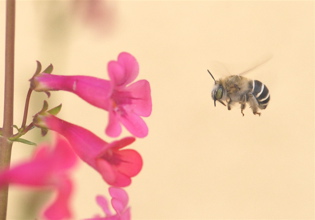Most of you probably recognize this little insect as a praying mantis. But can you tell how small it is? The milkweed flower bud next to it is roughly 1/3 inch long.
The praying mantis is looking for an insect to eat. As it eats and grows, it will shed its exoskeleton or outer “skin.” Unlike some insects that change a lot when they grow, the mantis will stay about the same. The biggest change will be that it will have wings when it becomes an adult.
Notice the triangle-shaped head with the large eyes. Those eyes could definitely see me trying to take its picture. It kept hiding behind the flower buds, so I had trouble getting a good photo.
Also notice the front legs tucked up under its body. The praying part of the mantis name comes from that posture. It actually uses those legs to grab prey.

 I just have to share the beautiful insect I found this morning on my hollyhocks. Look at the rainbow colors in her wings and her shiny golden eyes. She is so delicate and ethereal.
I just have to share the beautiful insect I found this morning on my hollyhocks. Look at the rainbow colors in her wings and her shiny golden eyes. She is so delicate and ethereal. This morning I took a few minutes from my daily grind to take a few photographs. The garden is in full bloom and a loud buzzing attracted me to the side garden. Here is what I found. Do you know what it is?
This morning I took a few minutes from my daily grind to take a few photographs. The garden is in full bloom and a loud buzzing attracted me to the side garden. Here is what I found. Do you know what it is?